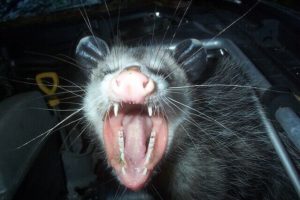Repelling Opossums
 Opossums are not considered cute by most people. Their eyes are beady, their fur isn’t especially attractive, and their tails are decidedly rat-like. While they have their fans, the creatures are generally seen as a nuisance. It doesn’t help that they are known for “playing dead” in order to deter predators and that they emit a truly putrid odor from their anal glands while doing so! The real issue with opossums is the problems they can create for your pets and livestock and the way they wreck gardens and other manicured outdoor areas while foraging for food. They can pose a real threat to chicken coops and, occasionally, other pets. They can also spread a variety of diseases to people and animals, including leptospirosis, tuberculosis, coccidiosis, spotted fever, and tularemia. They also spread fleas, ticks, mites, and lice. All very good reasons to look for a way to get rid of them!
Opossums are not considered cute by most people. Their eyes are beady, their fur isn’t especially attractive, and their tails are decidedly rat-like. While they have their fans, the creatures are generally seen as a nuisance. It doesn’t help that they are known for “playing dead” in order to deter predators and that they emit a truly putrid odor from their anal glands while doing so! The real issue with opossums is the problems they can create for your pets and livestock and the way they wreck gardens and other manicured outdoor areas while foraging for food. They can pose a real threat to chicken coops and, occasionally, other pets. They can also spread a variety of diseases to people and animals, including leptospirosis, tuberculosis, coccidiosis, spotted fever, and tularemia. They also spread fleas, ticks, mites, and lice. All very good reasons to look for a way to get rid of them!
Like all pests, there are a number of methods for getting rid of opossums. Some are better than others. They are fairly persistent critters. Do common methods like mothballs, ammonia, and other repellents work? In this article we will explore some common methods for getting rid of opossums and whether or not they work.
Moth balls
The basic function of mothballs is to stink. They contain naphthalene, or paradichlorobenzene, that sublimate, meaning they slowly break down from a solid to a gas and release toxic fumes. Heat intensifies the process of sublimation.
The thing is that sublimation is only truly effective in closed spaces. That is why mothballs work best on moths in closed spaces like closets, trunks, and drawers. Opossums do occasionally get stuck or nest in enclosed spaces like attics or under porches, but most of the time they simply don’t spend enough time in spaces that are enclosed enough for the mothballs to work. Additionally, as mentioned, opossums are extremely smelly themselves so strong smells don’t necessarily bother them as much as you might think. They tend to become desensitized to mothballs. Another concern is the danger that mothballs and their toxic fumes pose to people and pets.
Ammonia
Let’s start with the most basic fact about ammonia – it is extremely toxic. In small doses, it makes an excellent cleaner, but it isn’t something that you would want out in the open.
As with mothballs, ammonia doesn’t work well against opossums. It is simply too easy for them to ignore the smell and mask it with their own stench as they get used to it. It is also hit-or-miss when it comes to where you are going to place the ammonia, and whether the concentration you use will be enough. Ammonia is highly toxic and dangerous around pets and children. Too much risk for not enough reward.
Other Methods
There are a lot of different chemical repellents out there on the market that tout their ability to rid you of your opossum problem. Many of them present the same types of problems as mothballs and ammonia: they are toxic and it is too easy for opossums to become accustomed to them. Some more natural methods like hot pepper spray, animal hair, and even animal urine sprays can also be hit-or-miss, but sometimes work a bit better than chemical sprays.
What Works
One of the most important methods that does work is being careful with food. Secure all trash cans. Don’t feed pets outside. If some basic methods like noise, automatic lights, and fencing don’t work, you should consider calling a professional pest removal company to do the job.